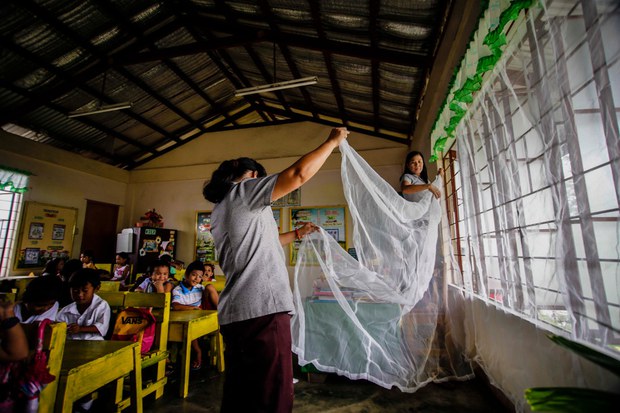Philippines Declares Dengue Alert as Cases top 100,000 in 2019
2019.07.15
Cotabato and Dagupan, Philippines
 Teachers install anti-dengue mosquito nets treated with insecticide on their classrooms windows and doors at Pantal Elementary School in Dagupan City, Philippines, July 2016
Teachers install anti-dengue mosquito nets treated with insecticide on their classrooms windows and doors at Pantal Elementary School in Dagupan City, Philippines, July 2016
Philippine health officials declared a nationwide “dengue alert” Monday in reporting that infections from the mosquito-borne disease shot up by 85 percent to more than 100,000 cases during the first half of 2019.
The Department of Health did not say how many people had died from dengue-related complications, but the World Health Organization (WHO) had recorded 398 fatalities from January to June 15 in the Philippines, compared with 275 the previous year.
“This is the first time that we’re declaring a national alert because the objective is very clear. We want to raise awareness among the public and, more importantly, in communities where signs of early dengue increases are evident,” Health Secretary Francisco Duque said.
Many of those who died from the disease this year were children. The government said 106,630 dengue cases were reported so far this year, up from 57,564 over the same period in 2018.
Despite the alert, Duque assured the public that there was no national epidemic in the Philippines.
Dengue fever and dengue hemorrhagic fever are acute viral infections that are known to affect infants, young children and adults. It is transmitted by a bite from an Aedes aegypti mosquito infected with any one of the four dengue strains.
A spike in the disease reaches its peak every three to four years, with the last occurring in 2016, Duque said. Without going into detail about what causes a spike, he said early detection and proper case management could prevent deaths.
Dengue should be suspected when a high fever (104 degrees Fahrenheit) is accompanied by two of the following symptoms: severe headache, pain behind the eyes, muscle and joint pains, nausea, vomiting, swollen glands or rash, WHO reported.
Warning signs of severe dengue occur three to seven days after the first symptoms and include severe abdominal pain, persistent vomiting, rapid breathing, bleeding gums, fatigue, restlessness and blood in vomit. Proper medical care is needed to avoid complications and risk of death.
The WHO said severe dengue was recognized in the 1950s during epidemics in the Philippines and Thailand.
“There is no specific treatment for severe dengue, but early detection and access to proper medical care lowers fatality rates below 1 percent,” WHO cited.
Among the Philippine regions that exceeded “epidemic threshold” are areas in Mindoro, Marinduque, Romblon and Palawan, where health officials have been alerted, according to Duque. The national disaster relief agency has placed these provinces under watch.
Vaccine scare
Earlier this year, the government blamed an uptick in measles cases on its immunization program suffering a setback following the Dengvaxia vaccine scare in late 2017.
Developed by French firm Sanofi Pasteur to counter dengue and administered to thousands of school children in the Philippines, Dengvaxia was discontinued after the firm said it caused severe infections among those who were vaccinated but had not previously contracted the disease.
“Dengue is a viral disease with no known vaccine or specific antivirals. Effective surveillance can help in reducing cases and deaths if areas with clustering of cases are identified early,” Duque said.
However, a Sanofi regional director told a Philippine congressional panel in 2018 that the drug was safe for public use.







